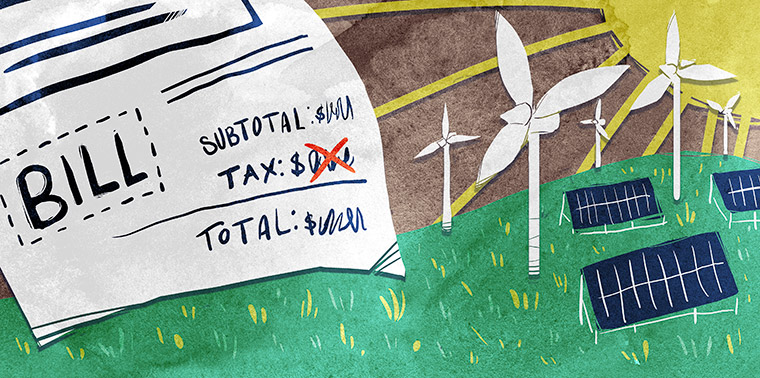March 13, 2017 — Recently some U.S. conservative leaders proposed a carbon tax to hedge the risks associated with climate change. We welcome these leaders to the climate realist caucus — and as we do, we also respectfully urge them to reconsider their support for a new tax scheme.
The idea of a carbon tax has been around for years, based on the notion that all products and services should be subject to a tax to internalize the societal costs of the carbon pollution they generate. The revenues from the tax would either go to “good” programs chosen by politicians, bureaucrats and lobbyists, or be returned to taxpayers to make up for rendering everything they buy a lot more expensive. In the meantime, the tax would serve as a deterrent to carbon emission.
The plan put forth by the conservative leaders would tax every product and service at the rate of US$40 per metric ton (1.1 tons) of carbon emitted. Assuming the U.S. emits 5.5 billion metric tons (6.1 billion tons) of carbon dioxide a year, that would yield US$220 billion a year that the federal government would hold before returning every penny to taxpayers in the form of dividend checks.
But here’s the problem with that approach: We just witnessed a presidential election in which the winning candidate tapped into Americans’ frustration with a lagging economy and an inefficient and ineffective federal bureaucracy. Then-candidate Trump focused on his view that the federal government was bungling trade, health care, education, veterans affairs and more. And it resonated with a public that has increasingly lost faith in the government.
Regrettably, the federal government’s history of commandeering entitlement trust funds isn’t going to make people confident either; doling out stimulus dollars to favored constituencies would make anyone skeptical about its ability to pursue a massive carbon-tax scheme without deciding to use the money for what they consider to be more pressing needs. For example, three years after the 2009 financial crisis, support for the ’09 stimulus package had lost one-third of its support, falling to 37 percent — in large part because of stories about the things lawmakers put into the bill, including, infamously, a $219,000 study of college “hookups.”
And, at least until we get the economy revved up again, conservative elected officials will likely view girding to fight for a carbon tax with as much enthusiasm as the British cavalry did for the Charge of the Light Brigade, and with good reason: Their hard-pressed constituents hate taxes even more than they do. Two recent polls on this point are instructive. First, 57 percent of respondents in a Gallup poll think the income tax they pay is “too high.” More directly relevant to the carbon tax scheme, Republican voters continue to overwhelmingly favor tax reform in huge numbers — the key data point to us being that 78 percent of GOP voters feel the tax code is too complicated.
We estimate that a zero emissions energy tax credit — ZEEC —would cut Americans’ electric bills by at least US$5.5 billion a year.We agree that prices affect behavior, because that’s the essence of the marketplace. But it’s a bidirectional phenomenon: prices going down work just as effectively as prices going up. So, yes, we can manipulate pricing to increase green innovation, reduce air pollution and address climate change — but, instead of taxing carbon and raising prices for everyone, let’s selectively remove taxes from electricity sources producing zero (or nearly zero) emissions (nuclear, wind, solar, geothermal, hydro) and incent further reductions in emissions from coal and natural gas facilities.
Since electricity is taxed across the board, providing a tax cut opportunity for zero-emissions facilities and a tax cut for reducing emissions from natural gas and coal plants will reduce utility bills for every ratepayer — and provide even greater relative benefit to the economically disadvantaged. We estimate that a zero emissions energy tax credit — ZEEC —would cut Americans’ electric bills by at least US$5.5 billion a year out of a total federal budget of around US$3.8 trillion. The best part is that a tax code approach allows us to cut from the nearly US$30 billion a year in existing subsidies.
But, more than that, a ZEEC would unleash investment into reducing the carbon footprint of energy generation. Today, about one-third of our country’s electricity comes from zero-emissions sources. A ZEEC would reward and incentivize growth and innovation in this crucial sector. And it would boost innovators seeking to reduce and capture emissions from natural gas- and coal-fired plants.
The potential benefits of a ZEEC would be huge. Not only would carbon be cut; so too would the sulfur and nitrogen oxides, mercury and particulates that contribute to asthma, emphysema and related human diseases and harm other animal and plant species.
The ingenuity and innovation spurred by a ZEEC would create new approaches to carbon capture and sequestration that would reduce emissions of pollutants and toxins across the planet.And the benefits would spread beyond our shores. The United States has 323 coal-fired power plants, but there are nearly 8,000 such plants worldwide. Because the U.S. is the patent capital of the world, the ingenuity and innovation spurred by a ZEEC would create new approaches to carbon capture and sequestration that would reduce emissions of pollutants and toxins across the planet.
And let’s not forget that a tax credit doesn’t require the bureaucracy to collect it, hold it and distribute it — and that saves every American even more hard-earned money.
Simply put, a ZEEC is the better way to proceed today. We hope that advocates of a carbon tax will find our alternative suggestion a more compelling one to solve the pressing problem of carbon pollution, and work with us to move swiftly towards a win-win-win for our ratepayers, our economy and our environment. ![]()
Editor’s note: The views expressed here are those of the author and not necessarily of Ensia. We present them to further discussion around important topics. We encourage you to respond with a comment below, following our commenting guidelines, which can be found on this page. In addition, you might consider submitting a Voices piece of your own. See Ensia’s Contact page for submission guidelines.
Ensia shares solutions-focused stories free of charge through our online magazine and partner media. That means audiences around the world have ready access to stories that can — and do — help them shape a better future. If you value our work, please show your support today.
Yes, I'll support Ensia!



When the incentive is to avoid using carbon people can choose to do that in multiple ways. They can come out ahead by being more energy efficient, by making lifestyle choices to use less energy, or by using solar or wind electricity. There are multiple ways to work within the market, which provides for innovation opportunities.
And you're completely off-base when you talk about the administrative burden somehow being easier with a tax-credit regime. Now you need inspectors to go out and look at facilities, administrative decisions on what qualifies, rules on whether a facility can partially qualify, and a determination on what size of a credit is appropriate for a particular type of facility. A carbon tax is stupidly easy, on the other hand. It's just an excise tax levied on a resource. Figure out how much carbon dioxide comes from burning a unit of fuel and tax accordingly. We already do this with fuels, as anyone who has read the fine print on a gas pump knows.
Reducing tax means the government would have less income for all its various activities.[unless it rasied some other taxes]
It must be recognised that governments everywhere seldom if ever adjust taxes for philanthropic or environmental reasons, but to balance the books.
By comparison the zero carbon tax credits proposed in the article would require complicated calculations of avoided carbon emissions across many diverse approaches.
Residential PACE has already shown an 80% year over year investment growth rate without the carbon tax stick in California. In residential PACE the owner can avoid energy costs and hence the amazing growth rate. Rental space is more problematic and needs a greater incentive i.e. a bigger stick such as a carbon tax. Commercial PACE has a meager 30% growth rate nationally.
The administrative infrastructure is already in place because we track fossil fuel extraction and imports for royalty and import duty purposes, so the mechanism is in place. The fee starts low and increases over time, which gives industry and consumers time to adjust and the predictability to plan ahead.
The fees collected are dividended back to citizens, so the average person has no net financial burden but still gets the market signal. The administrative structure for the dividend is the same as the Social Security structure, so it is already in place. The dividend goes to people with SSNs, so it is consistent with concerns about illegal immigration. The border adjustment is consistent with concerns about protecting the manufacturing sector.
And, best of all, the price signal is what drives change, not regulations. The economy is dynamic, not static, so when the price of fossil fuels rise there will be individually decided, and innovative, individual and business adaptations. And we can get rid of a host of top-down regulations.
But let's be clear about the myth that carbon capture and sequestration will work to clean up power plants.
Many engineers that I know, who are close to researching this subject, will tell you that it is not only not technically feasible because very few power plants are built on accommodating geology, but that it is also financially not feasible.
The technology today requires a significant amount of power from the plant to work, up to 50% of the planets output . Whatever is left can be used for revenue, which obviously drives the price of power from the plant sky high.
Here in West Virginia, where it is clean we have cheap coal power, the wholesale price according to AEP and other power companies is it lease 5.5 cents per kilowatt hour but can be as high as 7 cents.
Meanwhile, as the costs of Solar Energy have plunged 80% in the last decade, we are now seeing concentrated solar power plants built in of all places, oil rich Dubai and the Emirates, where they will produce electric power at 2.32-2.5 cents per kilowatt hour.
That real economic trend alone makes coal too expensive. But when you add all of the external costs, like healthcare, environmental damage, abandon mine reclamation, unfunded miners pensions to name just a few that are very real costs of coal, it is clearly no longer cheap at all.
The Bureau of Labor Statistics is not reporting that there are twice as many jobs in renewable energy as in the entire fossil fuel industry, coal, oil and gas.
Coal is on an economic death spiral. But here in our state we have learned that miners can be retrained, even the jobs in solar energy.
Other economic reports indicate that the solar industry alone is growing faster than the use of cell phones.
Job creating renewable energy is what we all should be demanding, investing in and embracing. And in so doing, we will be accelerating the transition to truly zero emission energy to benefit all of those us, all of our children and grandchildren.
The anthropogenic climate change crisis is very real. Scientists around the world have a higher consensus believe in that then they do about what causes gravity.
It's time to accelerate the transition to clean energy so that we avoid what could be catastrophic environmental condition in which survival of the human race is in question.
Also, government has been incentivizing green power sources for a very long time now.